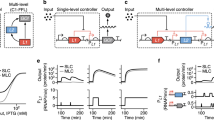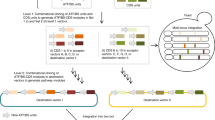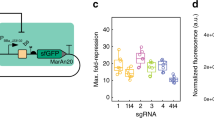Abstract
Many applications of synthetic biology require the balanced expression of multiple genes. Although operons facilitate coordinated expression of multiple genes in prokaryotes and eukaryotes, coordinating the many post-transcriptional processes that determine the relative levels of gene expression in operons by a priori design remains a challenge. We describe a method for tuning the expression of multiple genes within operons by generating libraries of tunable intergenic regions (TIGRs), recombining various post-transcriptional control elements and screening for the desired relative expression levels. TIGRs can vary the relative expression of two reporter genes over a 100-fold range and balance expression of three genes in an operon that encodes a heterologous mevalonate biosynthetic pathway, resulting in a sevenfold increase in mevalonate production. This technology should be useful for optimizing the expression of multiple genes in synthetic operons, both in prokaryotes and eukaryotes.
This is a preview of subscription content, access via your institution
Access options
Subscribe to this journal
Receive 12 print issues and online access
$209.00 per year
only $17.42 per issue
Buy this article
- Purchase on Springer Link
- Instant access to full article PDF
Prices may be subject to local taxes which are calculated during checkout




Similar content being viewed by others
References
Khosla, C. & Keasling, J.D. Metabolic engineering for drug discovery and development. Nat. Rev. Drug Discov. 2, 1019–1025 (2003).
Martin, V.J., Pitera, D.J., Withers, S.T., Newman, J.D. & Keasling, J.D. Engineering a mevalonate pathway in Escherichia coli for production of terpenoids. Nat. Biotechnol. 21, 796–802 (2003).
White, M.M. Pretty subunits all in a row: using concatenated subunit constructs to force the expression of receptors with defined stoichiometry and spatial arrangement. Mol. Pharmacol. 69, 407–410 (2006).
Endy, D. Foundations for engineering biology. Nature 438, 449–453 (2005).
Baga, M., Goransson, M., Normark, S. & Uhlin, B.E. Processed mRNA with differential stability in the regulation of E. coli pilin gene expression. Cell 52, 197–206 (1988).
Komar, A.A. & Hatzoglou, M. Internal ribosome entry sites in cellular mRNAs: mystery of their existence. J. Biol. Chem. 280, 23425–23428 (2005).
Martin, P., Albagli, O., Poggi, M.C., Boulukos, K.E. & Pognonec, P. Development of a new bicistronic retroviral vector with strong IRES activity. BMC Biotechnol. 6, 4 (2006).
Chappell, S.A. & Mauro, V.P. The internal ribosome entry site (IRES) contained within the RNA-binding motif protein 3 (Rbm3) mRNA is composed of functionally distinct elements. J. Biol. Chem. 278, 33793–33800 (2003).
Fernandez-Miragall, O., Ramos, R., Ramajo, J. & Martinez-Salas, E. Evidence of reciprocal tertiary interactions between conserved motifs involved in organizing RNA structure essential for internal initiation of translation. RNA 12, 223–234 (2006).
Nudler, E. & Gottesman, M.E. Transcription termination and anti-termination in E. coli. Genes Cells 7, 755–768 (2002).
Mandal, M. & Breaker, R.R. Gene regulation by riboswitches. Nat. Rev. Mol. Cell Biol. 5, 451–463 (2004).
Arraiano, C.M. & Maquat, L.E. Post-transcriptional control of gene expression: effectors of mRNA decay. Mol. Microbiol. 49, 267–276 (2003).
Kushner, S.R. mRNA decay in prokaryotes and eukaryotes: different approaches to a similar problem. IUBMB Life 56, 585–594 (2004).
de Smit, M.H. & van Duin, J. Control of translation by mRNA secondary structure in Escherichia coli. A quantitative analysis of literature data. J. Mol. Biol. 244, 144–150 (1994).
Isaacs, F.J. et al. Engineered riboregulators enable post-transcriptional control of gene expression. Nat. Biotechnol. 22, 841–847 (2004).
Majdalani, N., Vanderpool, C.K. & Gottesman, S. Bacterial small RNA regulators. Crit. Rev. Biochem. Mol. Biol. 40, 93–113 (2005).
Smolke, C.D., Carrier, T.A. & Keasling, J.D. Coordinated, differential expression of two genes through directed mRNA cleavage and stabilization by secondary structures. Appl. Environ. Microbiol. 66, 5399–5405 (2000).
Smolke, C.D. & Keasling, J.D. Effect of gene location, mRNA secondary structures, and RNase sites on expression of two genes in an engineered operon. Biotechnol. Bioeng. 80, 762–776 (2002).
Deana, A. & Belasco, J.G. Lost in translation: the influence of ribosomes on bacterial mRNA decay. Genes Dev. 19, 2526–2533 (2005).
Matz, M.V. et al. Fluorescent proteins from nonbioluminescent Anthozoa species. Nat. Biotechnol. 17, 969–973 (1999).
Pfleger, B.F., Fawzi, N.J. & Keasling, J.D. Optimization of DsRed production in Escherichia coli: effect of ribosome binding site sequestration on translation efficiency. Biotechnol. Bioeng. 92, 553–558 (2005).
Naureckiene, S. & Uhlin, B.E. In vitro analysis of mRNA processing by RNase E in the pap operon of Escherichia coli. Mol. Microbiol. 21, 55–68 (1996).
Kaberdin, V.R. Probing the substrate specificity of Escherichia coli RNase E using a novel oligonucleotide-based assay. Nucleic Acids Res. 31, 4710–4716 (2003).
Zuker, M. Mfold web server for nucleic acid folding and hybridization prediction. Nucleic Acids Res. 31, 3406–3415 (2003).
Spickler, C. & Mackie, G.A. Action of RNase II and polynucleotide phosphorylase against RNAs containing stem-loops of defined structure. J. Bacteriol. 182, 2422–2427 (2000).
Gottesman, S. The small RNA regulators of Escherichia coli: roles and mechanisms. Annu. Rev. Microbiol. 58, 303–328 (2004).
Burke, E. & Barik, S. Megaprimer PCR: application in mutagenesis and gene fusion. Methods Mol. Biol. 226, 525–532 (2003).
Sambrook, J., Fritsch, E.F. & Maniatis, T. . Molecular Cloning A Laboratory Manual. (Cold Spring Harbor Press, Cold Spring Harbor, NY, 1989).
Rodwell, V.W. et al. 3-Hydroxy-3-methylglutaryl-CoA reductase. Methods Enzymol. 324, 259–280 (2000).
Acknowledgements
The authors would like to acknowledge Vincent J.J. Martin, Jack D. Newman, Katherine D. McMahon, Sydnor T. Withers and Wesley D. Marner II for their constructive comments, Hector Nolla for performing FACS experiments, and Chris J. Paddon for performing the HMGR assays. This research was conducted under the sponsorship of the Institute for OneWorld Health, through the generous support of The Bill and Melinda Gates Foundation and by National Science Foundation Grant no. BES 9906405. D.J.P. is the recipient of a National Science Foundation graduate fellowship.
Author information
Authors and Affiliations
Contributions
B.F.P. designed and conducted experiments; D.J.P. designed and conducted experiments; C.D.S. designed experiments; J.D.K. designed experiments.
Corresponding author
Ethics declarations
Competing interests
J.D.K. is a founder of Amyris Biotechnologies, a company that may eventually use the optimized mevalonate operons and engineered bacterium described in this publication, to produce artemisinin. However, neither Amyris Biotechnologies nor the University of California will make any profit from the production and sale of artemisinin, the anti-malarial drug.
Supplementary information
Supplementary Fig. 1
Effect of TIGR on individual gene expression. (PDF 164 kb)
Supplementary Fig. 2
Effect of gene location on expression in the TIGR library. (PDF 210 kb)
Supplementary Fig. 3
Assembly of larger operons using megaprimers. (PDF 183 kb)
Supplementary Table 1
Oligonucleotides used in the study. (PDF 133 kb)
Supplementary Table 2
Features of TIGR Oligonucleotides. (PDF 136 kb)
Supplementary Table 3
Sequences of TIGRs from library samples. (PDF 142 kb)
Supplementary Table 4
Strains and plasmids used in this study. (PDF 108 kb)
Rights and permissions
About this article
Cite this article
Pfleger, B., Pitera, D., Smolke, C. et al. Combinatorial engineering of intergenic regions in operons tunes expression of multiple genes. Nat Biotechnol 24, 1027–1032 (2006). https://doi.org/10.1038/nbt1226
Received:
Accepted:
Published:
Issue Date:
DOI: https://doi.org/10.1038/nbt1226
This article is cited by
-
Methionine inducing carbohydrate esterase secretion of Trichoderma harzianum enhances the accessibility of substrate glycosidic bonds
Microbial Cell Factories (2024)
-
Genome-wide analysis reveals Hsf1 maintains high transcript abundance of target genes controlled by strong constitutive promoter in Saccharomyces cerevisiae
Biotechnology for Biofuels and Bioproducts (2023)
-
Biosynthesis pathways of expanding carbon chains for producing advanced biofuels
Biotechnology for Biofuels and Bioproducts (2023)
-
A blueprint for a synthetic genetic feedback optimizer
Nature Communications (2023)
-
Impact of the Synthetic Scaffold Strategy on the Metabolic Pathway Engineering
Biotechnology and Bioprocess Engineering (2023)



